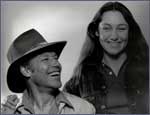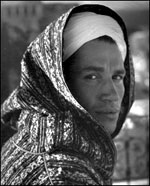 photo of "Ahmed and his daughter, Karima Yacoubi", circa 1983 by Felix Limardo Born in an ancient quarter of Fez, Morocco, Ahmed Yacoubi was the first Moroccan artist to exhibit and receive international acclaim. While translating for some tourists, the American writer and composer, Paul Bowles and his wife, play writer, Jane Bowles, Ahmed drew pictures to better communicate the meanings of Arabic and Moghrebi words to them. The Bowles recognized his unique talent which eventually resulted in a few local exhibitions and eventually his first one-man show at the Betty Parson’s Gallery, NY in 1952 where his very vivid and imaginative ink drawings were shown. Peggy Guggenheim exhibited three of his drawings in her Venice Palazzo Show and later purchased them for her private collection.When Francis Bacon came to Tangier he brought Ahmed his first oils and his technique changed radically from then on, developing a highly individualized and refined layering method that continued to reveal his lively, inner world. Shows of his new oils followed with further critical success around the world — Hong Kong, Ceylon, Rio de Janiero, London, Tokyo, etc. Hans Richter’s film “8X8” devoted footage to six artists: Yacoubi, Cocteau, Arp, Ernst, Duchamps, Kiesler, and Tanguy. La Musee d’Art Moderne in Paris purchased “Automne” and the Museum of Modern Art purchased “King Solomon’s Ring” in 1966 from the Bodley Gallery while other top collectors of the day acquired his work such as Helena Rubinstein, Jonathan Mayne, Sir Herbert Read, Montgomery Clift, Tennessee Williams, Eric Alport, Pierre Gassier, Albert Rothschild, El Duque de las Torres and many, many more.  Yacoubi moved to New York City permanently in the late sixties where Ellen Stewart provided him with a loft space in La Mama’s rehearsal building that Yacoubi transformed into “The Rising Night Gallery.” Amidst the changing art trends of the 70’s and 80’s, Yacoubi continued to delve with his singular and secretive oil techniques, maintaining the integrity of his inspired approach, producing magical scenes, portraits, and worlds that reveal his depth of insight into humanity and life. Yacoubi moved to New York City permanently in the late sixties where Ellen Stewart provided him with a loft space in La Mama’s rehearsal building that Yacoubi transformed into “The Rising Night Gallery.” Amidst the changing art trends of the 70’s and 80’s, Yacoubi continued to delve with his singular and secretive oil techniques, maintaining the integrity of his inspired approach, producing magical scenes, portraits, and worlds that reveal his depth of insight into humanity and life.
William Burroughs wrote of this non-literate genius: Ahmed Yacoubi is a painter, that is to say he creates life on canvas. His paintings are maps of psychic areas indicating the typography and life forms to be encountered there. Any artist is in fact a map maker and his work is valid in so far as his maps are accurate living maps. The photographer shoots his quarry and brings it back dead. The painter who is a painter presents a living map. Yacoubi is mapping timeless areas of magic therefore his work has a special relevance in the space age since these areas are now open to exploration and we may well look to artists for orientation. The painting of Yacoubi is a window opening into space. You do not look at his pictures but through them. Ahmed Yacoubi’s life, including his art, was magical. Between his intriguing art, delicious and healing culinary talents, transcribed poetry, short stories and play (“The Night Before Thinking”), or his beguiling personality, this faithful sheriff will remain outstanding for his artistic achievements and hospitable, humble disposition. Yacoubi traversed cultural and religious differences ahead of his time and through his humor and art, expressed a universality we still aspire to penetrate and comprehend.
|